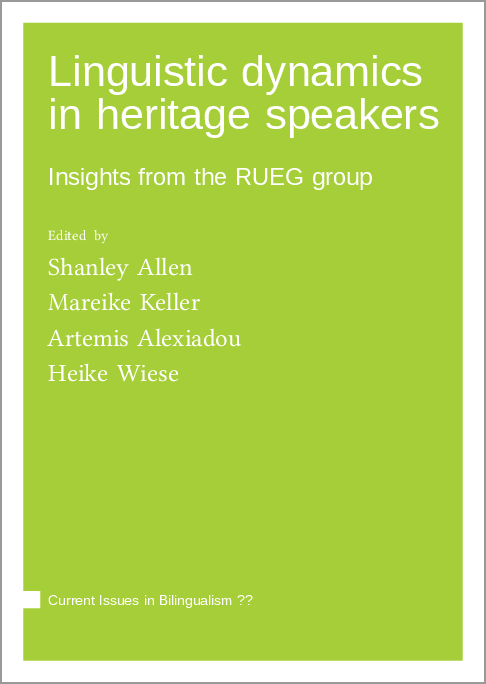We log anonymous usage statistics. Please read the privacy information for details.
Linguistic dynamics in heritage speakers: Insights from the RUEG group
Synopsis
This collective volume investigates linguistic dynamics in language contact, focusing on heritage speakers. The chapters provide new insights into the role of speaker repertoires and the distinction between contact-induced change and language-internal variation by reporting on corpus-linguistic studies across different communicative situations in heritage and majority languages. Conducted in the context of the DFG Research Unit “Emerging Grammars in Language Contact Situations” (FOR 2537), the studies focus on bilingual adolescent and adult speakers of German, Greek, Russian and Turkish as heritage languages, and of English and German as majority languages, and on monolingually raised adolescent and adult speakers of all five languages. Crucially, they are not restricted to standard language, but target broader speaker repertoires that cover informal as well as formal settings in both spoken and written modes. The contributions are united by their positive perspective on language contact and multilingual speakers, a comparative approach across several heritage and majority languages, and a shared methodology that captures variation within repertoires for both heritage speakers and monolinguals. The chapters take various theoretical standpoints, highlighting different facets of the data as well as its potential for enhancing our understanding of language contact and language variation.
Chapters
-
IntroductionInvestigating the dynamics of language-contact situations
-
Part I: Methodology and application
-
Tapping into speakers’ repertoiresElicitation of register-differentiated productions across groups
-
Mapping the mappings and then containing them allQuality assurance, interface modeling, and epistemology in complex corpus projects
-
Family Language DynamicsStrengthening heritage speakers’ linguistic resources
-
Part II: Dynamics of grammatical structure
-
Inter- and intra-individual variationHow it materializes in Heritage German and why it matters
-
Null subjects in heritage Greek, Russian and Turkish
-
Dynamics of verbal aspect in heritage Greek, Russian and Turkish
-
Clause combining in narrative discourseA contrastive analysis across heritage and majority languages
-
Balkan Turkic as a model for understanding contact-induced change in Turkish
-
Dynamic properties of the heritage speaker lexicon
-
Part III: Dynamics of pragmatic structure
-
Information packaging and word order dynamics in language contact
-
Intonation in heritage languages
-
Majority English of heritage speakers
-
Dynamics of discourse markers in language contact
-
Discourse openings and closings across languages in contact
Reviews
-
Review on LinguistList
by Daniel Strogen
published December 3, 2025
[...] Overall, this is a well-integrated contribution to research on heritage speakers and language contact. The volume brings together work on methodology, grammar, and pragmatics, showing how different linguistic levels can be compared across languages and contexts. Its combination of corpus-based, experimental, and qualitative approaches illustrates the range of current methods in the field without losing coherence. By analysing morphosyntax, prosody, and discourse organisation using shared data and comparable elicitation contexts, the contributors offer a consistent basis for cross-linguistic comparison and provide a model for future research on multilingual language use. [...]




